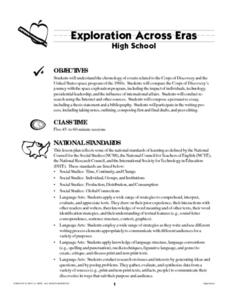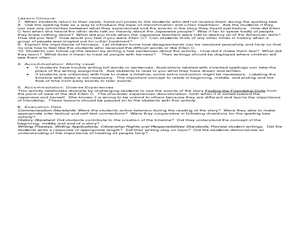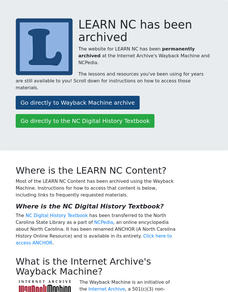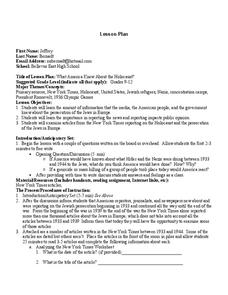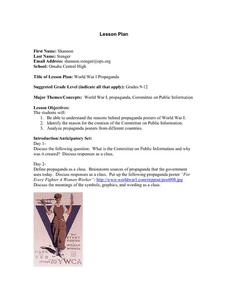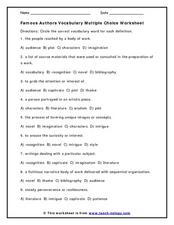Curated OER
Plea Bargaining
Students explore plea bargaining and list the advantages and disadvantages of it.
Curated OER
Exploration Across Eras
High schoolers discover the chronology of events related to the Corps of Discovery and the United States space program of the 1960s. They compare the Corps of Discovery's journey with the space exploration program.
Curated OER
Left Brain vs. Right Brain -- Which Side Are You On?
Students examine the different regions of the brain and what they are responsible for. They decide whether they are right or left- brain dominant based on their personalities.
Curated OER
Create Your Own Homophone Worksheets
Students develop their own homophone worksheet. They practice the spelling and using the different homophones. They participate in a homophone bee to end the lesson.
Curated OER
What Do You Do With An Orphaned Cheetah?
Learners brainstorm techniques for teaching baby cheetahs survival skills. In this science lesson, students view an episode of "Cheetah Orphans" and work together to analyze the situation and develop a plan to teach the baby cheetahs the...
Curated OER
Make a Model of a Wright Flyer
Learners recreate a model of the 1903 Wright Flyer out of Styrofoam. Students practice following instructions, and discover information about the Wright brothers' engine-powered glider.
Curated OER
California Biodiversity
Students examine several maps of California exhibiting features such as precipitation, topography, and vegetation. They look for patterns that might be the source of or influence biodiversity in different regions. They pay particular...
Curated OER
Finding the Friendship Dolls, A True Story: How Children Can Create World Peace
Students listen to the book Finding the Friendship Dolls, A True Story: How Children Can Help Create World Peace through Toys. In this world peace lesson, students choose events in the story to create a timeline of those events. Students...
Curated OER
Types of Chemical Reactions
Students conduct labs to gain an overview of chemical reactions. They observe examples of synthesis, decomposition, single displacement and double displacement reactions. They identify certain products by the use of litmus and splint tests.
Curated OER
Looking At Portraits: Literary Monuments
High schoolers examine artworks, research literature, and create study drawings and a 3-D model for a monument to a literary figure. They discuss and analyze the sculpture Model for a Monument to Alexandre Dumas p??re by Albert-Ernest...
Curated OER
What America Knew About the Holocaust?
Students examine American involvement in World War II. For this World War II lesson, students discuss the Holocaust and its implications. Students read New York Times articles regarding the treatment of Jews during the war. Students...
Curated OER
Teamwork And Productivity
Students engage in a creative project of constructing different things using origami paper. The objective is for them to construct something that is identified and useful at the same time. They use guided questions to go through the...
Curated OER
Socialization
Students discuss the behaviors associated with the role of a student and discover the meaning of the term socialization. They identify the agents of socialization and how they affect understanding of social expectations by examining them...
Curated OER
The Great Depression: A World Struggle
Learners research the impact of the Great Depression on the United States. In groups, they use the internet to describe each of FDR's New Deal Programs and how it helped unemployment. They also discuss how these programs affected the...
Curated OER
A Design for a Fireplace: Extreme Home Makeover
Students examine a relief structure focusing on style, relief, and design. Students discuss and analyze the sculpture Sketch for a Fireplace Overmantel by Francesco Antonio Franzoni. Students brainstorm about the current styles...
Curated OER
Looking at Portraits: Literary Monuments
Students examine artworks, research literature, create drawings, and make a 3-D model for a monument to a literary figure. For this literary portrait lesson, students discuss and analyze the sculpture Study of a Monument to Alexandre...
Curated OER
World War I Propaganda
Learners interpret historical evidence presented in primary and secondary resources. In this World War I lesson, students examine the propaganda techniques used by different nations during the war and analyze examples. Learners also...
Curated OER
A Design for a Fireplace
Students examine a relief sculpture. In this sculpting lesson, students analyze the sculpture "Sketch for a Fireplace Overmantel" by Francesco Franzoni. Students create a three-dimensional sketch for an overmantel using the styles of...
Curated OER
Immigration Myths
Young scholars discuss myths and stereotypes about different immigrant groups. In this immigration myths and tolerance activity, students work through six workstations in which they hypothesize where a particular myth originated...
Curated OER
Famous Authors Vocabulary Multiple Choice Worksheet
Don't let the title fool you, this worksheet has little to do with authors! Instead, it tests your middle schoolers on their knowledge of language arts vocabulary. Words like audience, intrigue, novel, and recognition are covered.
North Carolina Standard Curriculum
Rhythm Counting
Understanding time signatures and rhythm counting are two very important parts of playing an instrument well. Here are three basic lessons rolled into one that prompt upper graders to play their instruments with care. They'll practice...
Curated OER
Ride the Road to Freedom
Second graders discover that people can connect the dots of the stars to make pictures in the sky and have been doing so for thousands of years. They understand that throughout the United States people worked together to plan an escape...
Curated OER
What Can You Do With Money?
Students watch a Biz Kidz video about money, learn what they can do with money, and fill out worksheets on what they learn. Students learn about spending, saving, donating, and investing.
Curated OER
Eng 213 Final Exam
Use this presentation in your linguistics class as a review tool, or utilize the concepts within it to frame your curriculum. Covering vowel and consonant rules, morphophonemic spelling systems, and assimilation rules, this slide show...



